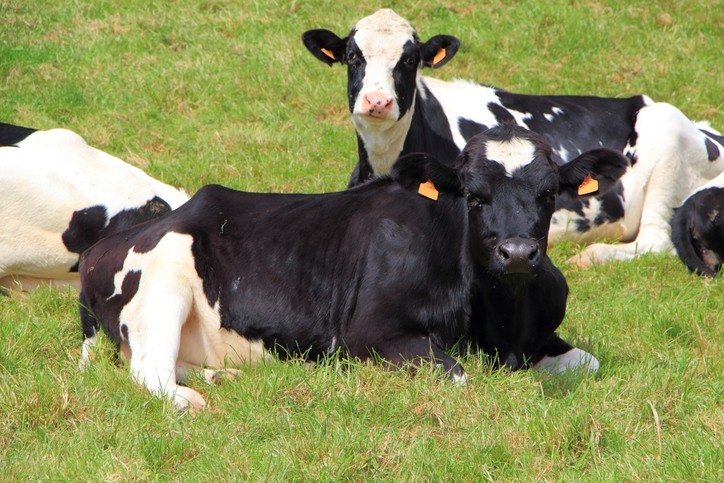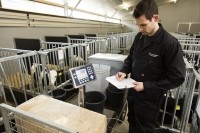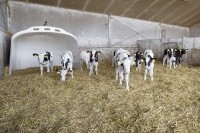Manipulation of metabolic development of calves is possible: Trouw Nutrition

The company’s longitudinal study follows 86 individually housed calves receiving either a traditionally low level of calf milk replacer, CMR, (0.6 kg/d); or an optimized level (1.2 kg/d) in line with the company’s LifeStart program.
Trouw Nutrition explained that calves were weaned at 56 days of age and group housed at 70 days of age and afterwards provided the same diet and management, with health, performance and metabolic parameters monitored and measured as they went through the production cycle. Factors such as parity of mother and colostrum feeding were controlled to ensure any effects could be attributed to plane of nutrition only.
The company said the trial showed calves on the optimized LifeStart feeding plan had sustained metabolic adaptations that remained even nine months after weaning. It said the LifeStart regime also appeared to lead to an earlier age at first calving, as well as improved survival to 180 days in milk.
FeedNavigator caught up with Trouw Nutrition researcher, Leonel Leal, to hear more.
“We confirmed in the first lactation findings what we already had seen at 11 months - the basal metabolism is different in the two groups.”
He said the team expects, by late this year, to have data on the first lactation milk production to see if actual production validates what the metabolism of the cows is indicating.
“What we see is that there are changes occurring in the basal metabolism of the animal. Some of the changes we saw at pre-weaning, again at 11 months and then, afterwards, in first lactation, would seem to be linked to the way the animal utilizes energy that it gets from the feed, how it partitions that energy towards body reserves or towards the milk. The same was also shown for the utilization of protein.
“We also saw some microbial derived secondary metabolites in the blood of those animals, which could indicate that the microbiome of the animals in the two groups is different. But that is still speculative and we need to do further research on this.”
The Lifestart research project started in Q1 2014. The research farm includes 120 dairy cows.
“We started in the beginning of 2014. It took us close to 18 months to have all the heifers we needed for our experiments. The pre-weaning phase took us a while and this why we have cows in first and second lactation. From the youngest calves to the oldest, there is an age differential of more than one year. We work with a small farm.”
Results so far…
He said in those four years, along with Trouw Nutrition’s own work, studies undertaken by other research groups show why enhanced nutrition pre-weaning could promote development and future production. The findings of collection of papers from Adam Geiger based at the Department of Dairy Science in Virginia Tech in the US, showed the mammary gland and organ size is dramatically impacted by pre-weaning nutrition regimes, said Leal.
“They (Geiger et al, 2016) have actually shown that there are some organs that can develop faster than other parts of the body, indicating that they are nutrient sensitive. And that was contrary to our original thinking that all organs develop at the same pace.”
On-farm measurements
He said the Trouw Nutrition team now has more data now to show it is not only developmental variance that matters, that the difference in cows fed higher planes of nutrition and restricted diets is also related to epigenetics and metabolic programming. The team sees that long-term metabolic configuration in an animal that can persist and can be expressed in time, all due to the higher plane of nutrition in the cow’s first two months of life.
“We will study if that happens still in the second lactation as well.
"In terms of other next steps, we will try and understand how all those changes in basal metabolism can relate to interesting parameters for a farmer – essentially milk production, milk composition, dry matter intake, longevity, fertility and resilience.
“A bridge now needs to be made with what science is telling us regarding the metabolites of calves [fed a higher planer of nutrition] and on-farm measurements.”
Expressing advantage
Some published research shows no differential in milk production in calves fed a higher or restricted feeding regime pre-weaning.
Commenting on such findings, Leal said:
“Those studies normally always focus on milk yield in the first lactation but ignore other parameters such as longevity or fertility and a range of other parameters we still don’t understand.
“We have discussed that pre-weaning nutrition is extremely important for first lactation milk yield but the way the metabotype is going to be expressed in the future will also depend on the environment the cow is exposed to – whether it is the lactation diet, housing conditions and management – the same metabotype may behave differently – it is all about how the animal may handle those nutrients and that diet in the future.
“You may not see differences in liters of milk per day but you may see that those animals perform better in other production parameters such as health, fertility and resilience.”
Comprehensive analysis of several parameters at the same time is necessary to show how the effects of a higher plane of nutrition in the first eight weeks can ensure better lifetime performance, said Leal.
“I always explain to farmers that the conditions during the first lactation can change the way the animals express their advantage.”
Longevity focus
The Trouw Nutrition team is aiming to, eventually, have strong datasets for first and second lactation. “One of the things we are trying to tackle is to extend the longevity of our dairy herds. Milk yield is important, and showing that response through our higher plane of nutrition feeding certainly captured the attention of the entire scientific community, but I think we are better off increasing the longevity of the animals. That is even more important, not only for economic and productivity reasons, but for reasons of societal perception [of dairy farming].”















